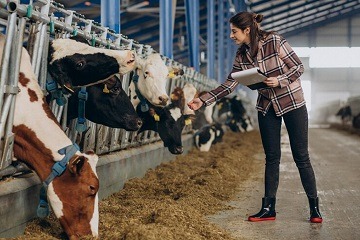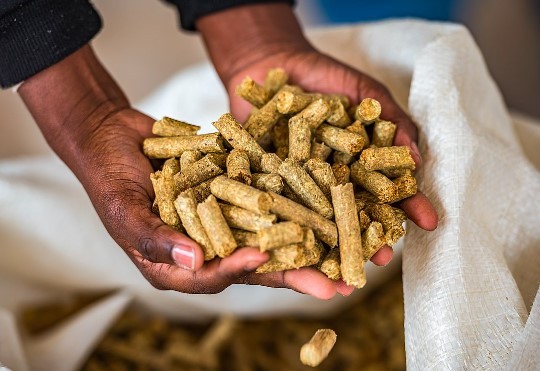#global animal feed market
Explore tagged Tumblr posts
Text
Exploring Innovations Revolutionizing the Animal Feed Industry

Introduction
The global animal feed market was valued at over USD 460 billion in 2021 and is projected to exceed USD 650 billion by 2028, registering a compound annual growth rate CAGR of 4% during the forecast period. The Animal Feed Market is experiencing dynamic changes driven by evolving consumer preferences, technological advancements, and sustainability initiatives. This in-depth analysis delves into the latest innovations shaping the animal feed industry, providing insights into key trends, opportunities, and challenges for stakeholders.
Innovations Driving the Animal Feed Market:
Alternative Protein Sources:
With the escalating demand for sustainable and plant-based diets, alternative protein sources for animal feed formulations are gaining momentum.
Innovations in insect protein production, algae cultivation, single-cell proteins, and microbial biomass offer sustainable alternatives to conventional protein sources like soybean meal and fishmeal.
These alternative protein sources not only promote environmental sustainability but also provide essential nutrients for animals while reducing reliance on scarce resources.
Precision Nutrition:
Advancements in precision nutrition technologies are reshaping feed formulation and delivery, enabling customized diets tailored to individual animals' specific nutritional requirements.
Technologies such as near-infrared spectroscopy (NIRS), metabolomics, and predictive modeling enable real-time monitoring of animal health, performance, and nutrient utilization, leading to more efficient feed management practices.
The precision nutrition segment is anticipated to witness substantial growth, driven by increasing investments in digital technologies and data analytics, with the market expected to surpass USD 3 billion by 2028.
Alternative protein sources are expected to capture a significant market share, with insect protein alone projected to reach USD 1.5 billion by 2028.
Functional Feed Additives:
Functional feed additives, including probiotics, prebiotics, enzymes, organic acids, and botanical extracts, are gaining prominence for their potential to enhance animal health, immunity, and performance.
These additives support gut health, improve nutrient absorption, and mitigate the adverse effects of stress, pathogens, and environmental challenges on animal welfare.
Innovations in encapsulation and delivery technologies are enhancing the stability and efficacy of functional additives, ensuring their effectiveness throughout the animal's digestive tract.
Blockchain and Traceability:
Blockchain technology is increasingly being harnessed to enhance transparency, traceability, and accountability in the animal feed supply chain.
Through blockchain-based platforms, stakeholders can track feed ingredient journeys from farm to fork, ensuring compliance with quality standards, safety regulations, and sustainability criteria.
Blockchain facilitates seamless data sharing and verification across the supply chain, mitigating the risks of fraud, contamination, and mislabeling, thereby safeguarding animal and human health while bolstering consumer trust.
Challenges and Opportunities
Regulatory Hurdles:
Despite the potential benefits of innovative feed technologies, regulatory hurdles and approval processes can impede their adoption and commercialization.
Stakeholders must navigate complex regulatory landscapes and demonstrate the safety, efficacy, and sustainability of novel feed ingredients and additives to gain regulatory approval and market acceptance.
Cost Considerations:
The adoption of innovative feed technologies may involve higher initial costs and necessitate investment in research and development.
Stakeholders must carefully evaluate the cost-benefit ratio of implementing new technologies, considering factors such as feed efficiency improvements, animal performance gains, and long-term sustainability benefits.
Conclusion
Innovation is driving profound changes in the Animal Feed Market, offering transformative solutions to meet the evolving needs of livestock producers, consumers, and the environment. By embracing cutting-edge technologies and addressing regulatory challenges, stakeholders can unlock new opportunities for sustainable and profitable animal nutrition solutions while ensuring the health, welfare, and productivity of animals.
#Animal Feed Suppliers#Animal Feed Companies#Animal Feed Additives Market#Animal Feed Market Share#Animal Feed Market#Animal Feed Industry#Animal Feed Market Size#Compound Feed Market#Global Animal Feed Market#Global Animal Feed Market Size#Animal Feed Composition Market#Animal Feed Industry Trends#Animal Feed Market Growth#Animal Feed Market Challenges#Animal Feed Market Type#Animal Feed Market Research Reports#Animal Feed Industry Research Reports#Animal Feed Supplements Market#Animal Feed Suppliers Market
0 notes
Text
A Deep Dive into Animal Feed Market: Growth, Share and Outlook

Introduction: Nourishing the Global Agricultural Tapestry through Animal Feed
The agricultural tapestry is intricately woven with various threads, and at the heart of this complex web lies the Animal Feed Market a linchpin that not only sustains but significantly influences the health, productivity, and well-being of livestock worldwide. This comprehensive exploration embarks on a journey to unravel the multifaceted dynamics of the animal feed industry, delving deep into market intricacies, size, composition trends, growth patterns, and the pivotal role it plays in shaping the broader agricultural landscape.
Animal Feed Market Share: Unraveling Strategic Influence
Central to our exploration is the strategic influence wielded by players in the Animal Feed Market Share realm. An in-depth understanding of how market share is distributed among key industry players unveils the intricate dynamics of resource allocation and the strategic influence these entities exert in steering the course of global agriculture.
Animal Feed Market Size: Scaling Impact on Livestock Nutrition
Beyond mere statistics, the impact on livestock nutrition is paramount in assessing the true significance of the Animal Feed Market Size. This metric not only gauges the vastness of the market but, more importantly, underscores the critical role animal feed plays in ensuring the health and productivity of livestock populations on a global scale. The global Animal Feed Market is positioned at an impressive USD X billion, affirming its pivotal role in sustaining and enhancing global livestock populations.

Global Animal Feed Market: Bridging Continents through Nutritional Connectivity
The interconnectedness of agriculture on a global scale comes to the fore in the expansive reach of the Global Animal Feed Market. This segment explores the cross-continental dynamics, trade relationships, and collaborative efforts that define the global distribution and consumption of animal feed, forming a nexus that nourishes livestock populations worldwide.
Trade Insight:
A notable Y% increase in cross-border trade in animal feed products over the past fiscal year exemplifies the interconnected nature of global agriculture.
Animal Feed Composition Market: Innovations in Nutritional Formulas
The evolution of animal feed finds expression in the realm of Animal Feed Composition Market. This section delves into the innovations and trends in formulating nutritionally balanced feeds, enhancing the health, growth, and overall well-being of livestock.
Innovation:
The surge in demand for customized animal feed compositions tailored to specific livestock needs is fueled by an increasing emphasis on precision nutrition.
Animal Feed Industry Trends: Navigating the Path of Progressive Evolution
The trajectory of the animal feed industry is marked by dynamic trends that shape the future of livestock nutrition. The Animal Feed Industry Trends section explores innovations such as sustainable feed sourcing, the incorporation of alternative proteins, advancements in feed processing technologies, and the integration of digital solutions for precise nutritional monitoring.
Emerging Trend:
The adoption of insect-based proteins in animal feed formulations has witnessed a notable Z% increase, signaling a paradigm shift towards sustainable and alternative protein sources.
Animal Feed Market Growth: Addressing the Rising Global Demand
At the core of the animal feed industry beats the pulsating rhythm of Animal Feed Market Growth. Beyond numerical expansion, this growth signifies the industry's commitment to meeting the rising demand for high-quality and nutritionally enriched feed products, driven by the increasing global population and the growing awareness of the importance of animal nutrition. The Animal Feed Market witnessed a remarkable Y% growth in the past fiscal year, underlining its pivotal role in sustaining and enhancing global livestock populations.
Conclusion: Nurturing Livestock, Empowering Agriculture into the Future
In conclusion, our exploration of the Animal Feed Market transcends the confines of a mere study in agricultural commodities. It is a testament to the industry's crucial role in not just sustaining but enhancing the global livestock population, thereby contributing to the well-being of the broader global population. From the nuanced dynamics of market share guiding resource allocation to industry trends, innovations, and growth trajectories, each facet contributes to the resilience and evolution of the animal feed sector. As the market continues to grow, adapt, and address challenges, it remains a linchpin in ensuring the health, productivity, and sustainability of livestock populations, thereby empowering the broader landscape of global agriculture.
#animal feed market share#animal feed market size#global animal feed market#animal feed composition market#animal feed industry trends#animal feed market growth#animal feed market#animal feed market type#animal feed market research reports
0 notes
Text
Boosting Animal Health with Amino Acids
Amino acids are essential for animal growth and health. Incorporating them into feed formulations can significantly enhance livestock production. Explore how amino acids can make a difference in animal farming!
For More Information Click Here

0 notes
Text
Animal Feed Ingredients Market Value, Growth, and Trends

Global Animal Feed Ingredients Market Report from AMA Research highlights deep analysis on market characteristics, sizing, estimates and growth by segmentation, regional breakdowns & country along with competitive landscape, player’s market shares, and strategies that are key in the market. The exploration provides a 360° view and insights, highlighting major outcomes of the industry. These insights help the business decision-makers to formulate better business plans and make informed decisions to improved profitability. In addition, the study helps venture or private players in understanding the companies in more detail to make better informed decisions. Major Players in This Report Include, .Archer-Daniels-Midland Company (United States), Mosaic Company (United States), J.R. Simplot Company (United States), Cargill, Incorporated (United States), Grain Millers, Inc. (United States), AB Vista (South Africa), BASF SE (Germany), Koninklijke DSM N.V. (Netherlands), Darling Ingredients (United States) , Dupont (United States). Free Sample Report + All Related Graphs & Charts @: https://www.advancemarketanalytics.com/sample-report/3157-global-animal-feed-ingredients-market Animal Feed Ingredients are used in animal feed to fulfill their nutritional requirements. These ingredients support the growth of animals. These ingredients provide highly nutritious diets that improve the quality of end products like meat, milk, and eggs while also maintaining the health of the animals. Consumers' rising per capita intake of meat and milk has necessitated the need for healthier animals. The growing popularity of poultry-based foods is expected to boost demand for animal feed ingredients. Market Drivers
Rising Demand For Meat From Food Industry
Growing Awareness Regarding The Nutritional Benefits Of Ingredients
Market Trend
Emergence Of Plant Based Nutrition’s
Opportunities
Rising Population Along With Growing Economic Standards
Increase In Demand For Pet Food Due To Rising In Awareness Among The Pet Owners
Challenges
Concern Over Quality Of Feed Due To Adulteration
Enquire for customization in Report @: https://www.advancemarketanalytics.com/enquiry-before-buy/3157-global-animal-feed-ingredients-market In this research study, the prime factors that are impelling the growth of the Global Animal Feed Ingredients market report have been studied thoroughly in a bid to estimate the overall value and the size of this market by the end of the forecast period. The impact of the driving forces, limitations, challenges, and opportunities has been examined extensively. The key trends that manage the interest of the customers have also been interpreted accurately for the benefit of the readers. The Animal Feed Ingredients market study is being classified by Type (Grains, Milling Byproducts, Added Vitamins, Minerals, Fats/Oils, Others), Application (Poultry, Ruminants, Swine, Aquatic Animals, Other Animals (Pet Animals, Birds, and Reptiles)), Form (Dry, Liquid), Sales Channel (Online, Offline) The report concludes with in-depth details on the business operations and financial structure of leading vendors in the Global Animal Feed Ingredients market report, Overview of Key trends in the past and present are in reports that are reported to be beneficial for companies looking for venture businesses in this market. Information about the various marketing channels and well-known distributors in this market was also provided here. This study serves as a rich guide for established players and new players in this market. Get Reasonable Discount on This Premium Report @ https://www.advancemarketanalytics.com/request-discount/3157-global-animal-feed-ingredients-market Extracts from Table of Contents Animal Feed Ingredients Market Research Report Chapter 1 Animal Feed Ingredients Market Overview Chapter 2 Global Economic Impact on Industry Chapter 3 Global Market Competition by Manufacturers Chapter 4 Global Revenue (Value, Volume*) by Region Chapter 5 Global Supplies (Production), Consumption, Export, Import by Regions Chapter 6 Global Revenue (Value, Volume*), Price* Trend by Type Chapter 7 Global Market Analysis by Application ………………….continued This report also analyzes the regulatory framework of the Global Markets Animal Feed Ingredients Market Report to inform stakeholders about the various norms, regulations, this can have an impact. It also collects in-depth information from the detailed primary and secondary research techniques analyzed using the most efficient analysis tools. Based on the statistics gained from this systematic study, market research provides estimates for market participants and readers. Contact US : Craig Francis (PR & Marketing Manager) AMA Research & Media LLP Unit No. 429, Parsonage Road Edison, NJ New Jersey USA – 08837 Phone: +1 201 565 3262, +44 161 818 8166 [email protected]
#Global Animal Feed Ingredients Market#Animal Feed Ingredients Market Demand#Animal Feed Ingredients Market Trends#Animal Feed Ingredients Market Analysis#Animal Feed Ingredients Market Growth#Animal Feed Ingredients Market Share#Animal Feed Ingredients Market Forecast#Animal Feed Ingredients Market Challenges
0 notes
Text

Animal nutrition emphases on dietary needs of animals, primarily those in food production and agriculture, but also in aquariums, zoos, and flora and fauna management.
Read More: https://cmi-reports.blogspot.com/2023/06/global-animal-nutrition-market-growth.html
#coherent market insights#healthcare Industry#Pharmaceutical#Global Animal Nutrition Market#Livestock feed#Nutritional supplements#Animal health#Animal welfare
0 notes
Text
#Animal Feed Organic Trace Minerals Market COVID-19 Analysis Report#Animal Feed Organic Trace Minerals Market Demand Outlook#Animal Feed Organic Trace Minerals Market Primary Research#Animal Feed Organic Trace Minerals Market Size and Growth#Animal Feed Organic Trace Minerals Market Trends#Animal Feed Organic Trace Minerals Market#global Animal Feed Organic Trace Minerals market by Application#global Animal Feed Organic Trace Minerals Market by rising trends#Animal Feed Organic Trace Minerals Market Development#Animal Feed Organic Trace Minerals market Future#Animal Feed Organic Trace Minerals Market Growth#Animal Feed Organic Trace Minerals market in Key Countries#Animal Feed Organic Trace Minerals Market Latest Report#Animal Feed Organic Trace Minerals market SWOT analysis#Animal Feed Organic Trace Minerals market Top Manufacturers#Animal Feed Organic Trace Minerals Sales market#Animal Feed Organic Trace Minerals Market COVID-19 Impact Analysis Report#Animal Feed Organic Trace Minerals Market Primary and Secondary Research#Animal Feed Organic Trace Minerals Market Size#Animal Feed Organic Trace Minerals Market Share#Animal Feed Organic Trace Minerals Market Research Analysis#Animal Feed Organic Trace Minerals Market Trends and Outlook#Animal Feed Organic Trace Minerals Industry Analysis
0 notes
Text
https://www.databridgemarketresearch.com/reports/global-blockchain-in-agriculture-market
0 notes
Text
#JH BIO -Leading chinese multinational manufacturer and distributor of feed ingredients with years of experience in the animal nutrition#feed industries of worldwide. Being a biotecnology company has not only taught us to focus on supplying the best products#but also to offer a dedicated and sincere service at all times to our customers. From product quality and safety#with an understanding of pricing according to market conditions and trends#to global delivery service and on-time transportation.
1 note
·
View note
Text
Leather vs. Pleather: 8 Myths Debunked
Since we are all beyond tired of seeing the same regurgitated leather posts every day, I've compiled and briefly debunked some of the most common myths peddled about leather and pleather… So hopefully we can all move on to talk about literally anything else.
1) Leather is not sustainable.
Approximately 85% of all leather (almost all leather you'll find in stores) is tanned using chromium. During the chrome tanning process, 40% of unused chromium salts are discharged in the final effluents, which makes it's way into waterways and poses a serious threat to wildlife and humans. There are also significant GHG emissions from the sheer amount of energy required to produce and tan leather.
Before we even get the cow's hide, you first need to get them to slaughter weight, which is a hugely resource-intensive process. Livestock accounts for 80% of all agricultural land use, and grazing land for cattle likely represents the majority of that figure. To produce 1 pound of beef (and the subsequent hide), 6-8 pounds of feed are required. An estimated 86% of the grain used to feed cattle is unfit for human consumption, but 14% alone represents enough food to feed millions of people. On top of that, one-third of the global water footprint of animal production is related to cattle alone. The leather industry uses greenwashing to promote leather as an eco-friendly material. Leather is often marketed as an eco-friendly product, for example, fashion brands often use the Leather Working Group (LWG) certificate to present their leather as sustainable. However, this certification (rather conveniently) does not include farm-level impacts, which constitute the majority of the negative environmental harm caused by leather.
2) Leather is not just a byproduct.
Some cows are raised speciifically for leather, but this a minority and usually represents the most expensive forms of leather. This does not mean that leather is just a waste product of beef and dairy, or that it is a completely incidental byproduct; it is more accurate to call leather a tertiary product of the beef and dairy industries. Hides used to fetch up to 50% of the total value of the carcass, this has dropped significantly since COVID-19 to only about 5-10%, but this is recovering, and still represents a significant profit margin. Globally, leather accounts for up to 26% of major slaughterhouses’ earnings. Leather is inextricably linked to the production of beef and dairy, and buying leather helps make the breeding, exploitation and slaughter of cows and steers a profitable enterprise.
3) Leather is not as biodegradable as you think.
Natural animal hides are biodegradable, and this is often the misleading way leather that sellers word it. "Cow hide is fully biodegradable" is absolutely true, it just purposely leaves out the fact that the tanning process means that the hide means that leather takes between 25 and 40 years to break down. Even the much-touted (despite it being a tiny portion of the market) vegetable-tanned leather is not readily biodegradable. Since leather is not recyclable either, most ends up incinerated, or at landfill. The end-of-life cycle and how it relates to sustainability is often massively overstated by leather sellers, when in fact, it is in the production process that most of the damage is done.
4) Leather is not humane.
The idea that leather represents some sort of morally neutral alternative to the evils of plastic is frankly laughable, at least to anyone who has done even a little bit of research into this exploitative and incredibly harmful industry. Cows, when properly cared for, can live more than fifteen years. However, most cows are usually slaughtered somewhere around 2-3 years old, and the softest leather, most luxurious leather comes from the hide of cows who are less than a year old. Some cows are not even born before they become victim to the industry. Estimates vary, but according to an EFSA report, on average 3% of dairy cows and 1.5 % of beef cattle, are in their third-trimester of pregnancy when they are slaughtered.
Slaughter procedures vary slightly by country, but a captive bolt pistol shot to the head followed by having their throats slit, while still alive, is standard industry practice. This represents the “best” a slaughtered cow can hope for, but many reports and videos exist that suggest that cows still being alive and conscious while being skinned or dismembered on the production line is not uncommon, some of these reports come from slaughterhouse workers themselves.
5) Leather often involves human exploitation.
The chemicals used to tan leather, and the toxic water that is a byproduct of tanning, affect workers as well as the environment; illness and death due to toxic tanning chemicals is extremely common. Workers across the sector have significantly higher morbidity, largely due to respiratory diseases linked to the chemicals used in the tanning process. Exposure to chromium (for workers and local communities), pentachlorophenol and other toxic pollutants increase the risk of dermatitis, ulcer nasal septum perforation and lung cancer.
Open Democracies report for the Child Labour Action Research Programme shows that there is a startlingly high prevalence of the worst forms of child labour across the entire leather supply chain. Children as young as seven have been found in thousands of small businesses processing leather. This problem is endemic throughout multiple countries supplying the global leather market.
6) Pleather is not a ‘vegan thing’.
Plastic clothing is ubiquitous in fast fashion, and it certainly wasn’t invented for vegans. Plastic leather jackets have been around since before anyone even knew what the word vegan meant, marketing department have begun describing it as ‘vegan leather’ but it’s really no more a vegan thing than polyester is. Most people who wear pleather are not vegan, they just can’t afford to buy cow’s leather, which remains extremely expensive compared to comparable fabrics.
It is striking how anti-vegans consistently talk about how ‘not everyone can afford to eat plant-based’ and criticise vegans for advocating for veganism on that basis, yet none of them seem to mind criticisms directed at people for wearing a far cheaper alternative than leather. You can obviously both be vegan and reduce plastic (as we all should), but vegans wear plastic clothing for the same reason everyone else does: It is cheaper.
7) Plastic is not the only alternative.
When engaging in criticism of pleather, the favourite tactic seems to be drawing a false dilemma where we pretend the only options are plastic and leather. Of course, this is a transparent attempt to draw the debate on lines favourable to advocates of leather, by omitting the fact that you can quite easily just buy neither one.
Alternatives include denim, hemp, cork, fiber, mushroom fiber, cotton, linen, bamboo, recycled plastic, and pinatex, to name a few. Alternatives exist for everything from materials designed to ensure sub-zero temperatures and specialist motorcycle equipment. There are exceptions in professions like welding, where an alternative can be difficult to source, but nobody needs a jacket, shoes or a bag that looks like leather. For most of us, leather is a luxury item that doesn’t even need to be replaced at all.
If you'd like to see a detailed summary of the comparison between leather/wool and plastic, as well as the available alternatives, you can find that here.
8) Leather is not uniquely long-lasting.
The longevity of leather is really the only thing it has going for it, environmentally speaking. Replacing an item less often means fewer purchases, and will likely have a lower environmental impact than one you have to replace regularly. Leather is not unique in this respect, however, and the idea that it is, is mostly just effective marketing.
As your parents will tell you, a well-made denim jacket can last a lifetime. Hemp and bamboo can both last for decades, as can cork and pinatex. Even cotton and linen can last for many years when items are looked after well. While some materials are more hard wearing than others, how long an item will last is mostly the result of how well made the product is and how well it is maintained, not whether or not the item is leather.
488 notes
·
View notes
Text
Follow-up to my Fanroad Magazine archival scan post - let's look at some cute 90's anime art! Just random ones that caught my eye:

"Hey, what happened to me!?" As mentioned, this came out before End of Eva did - as such, Asuka & crew really didn't get much of an ending in the TV show. 100% how she would react to watching episode 26, props to our artist (春原てるも/Kasuhara Terumo)

There are just so many "Rei running with toast" pieces, it was clearly a combination of a meme amoung the fans and the theme for the magazine. Love how this one brought marmalade too - never compromise on taste, no matter how late you are.
(The artist's name is "actually, I'm a Shinji fan" btw lol)


I love finds like these - these toast-lugging Rei's are by people who are professional mangaka today! The first is by いちば仔牛/Ichiba Kousei, or "Marketplace Cow" - it ain't their birth name I am sure - and they are a founding member of the doujin circle UGO - which is still going strong! And our second is by (I am 80% sure on this one) うおなてれぴん/Uona Terepin, a quite-accomplished artist who adorably published their first professional work in 1997, a year after this. Their twitter feed is 50% big titty girls and 50% model tanks, absolutely based.

Hot👏Shinji👏Fucks👏, this piece is amazing. What else do I have to say? (緋月れん/Hizuki Ren - maybe, translating Japanese names with no context is hard guys -_-)


This is one of my favourite trends - so Evangelion has a lot of technobabble? And it is very frequently in English. So fans really liked recreating that aesthetic in their art. But in 1996 they didn't have access to like screengrabs from the show or scanned splatbooks on hand? Which meant they just used ~whatever English text they could find - generally newspapers at their university or library. Which means we get Toast Rei splashed on reports of stock indices in the global financial markets, and this beautiful moe-Rei/Asuka looking solemnly out over, uh, some report about housing prices and cholesterol levels? Technobabble indeed! (嶋屋みえ/Shimaya Mei, まなせ貴也/Manase Takaya)

Rei clone army! Adorable. (藤桜智美/Fujisakura Tomomi)
Okay, moving away from Eva, there is in fact a bunch of other properties in here with fanart, but these types stood out to me:


That seinen "Kids on the Street" energy that was peaking in the 90's; fully ~aesthetic. (Keiko Kuyuki)
And to end on a weird note:

One section of the magazine is just a free-for-all of thoughts, and one Yayoi Hirone decided to give us a girl caught in the middle of undressing...alongside a recipe for cooking shrimp. Which, if I am being honest, is a huge improvement over the bullshit they throw on recipes online these days. This is the future we could have had -_-
Anyway, I hope that was fun - if anyone is struck or amused by some of the art in the magazine, I would be happy to see what stood out to you!
94 notes
·
View notes
Text
Exploring Innovations in the Animal Feed Market Forecast 2028

Market Size and Growth
The Animal Feed Market is witnessing robust growth globally, fueled by the increasing demand for high-quality animal protein, growing livestock populations, and rising consumer awareness about animal nutrition and welfare. According to recent market research reports, the global animal feed market was valued at over USD 460 billion in 2021 and is projected to exceed USD 650 billion by 2028, registering a compound annual growth rate CAGR of 4% during the forecast period.
Key Drivers of Market Growth
Rising Meat Consumption:
The growing global population, rising disposable incomes, and changing dietary preferences are driving an increase in meat consumption worldwide.
As a result, there is a corresponding rise in demand for animal feed to support the production of livestock, poultry, and aquaculture species.
Expansion of Livestock Production:
Developing economies, particularly in Asia-Pacific and Latin America, are witnessing rapid urbanization and industrialization, leading to the expansion of intensive livestock farming operations.
This trend is driving the need for efficient and nutritious animal feed formulations to support the health, growth, and productivity of livestock and poultry.
Technological Advancements:
Innovations in feed processing technologies, such as extrusion, pelleting, and micronization, are improving the digestibility, palatability, and nutritional value of animal feeds.
Advanced feed additives and supplements, including vitamins, minerals, amino acids, and growth promoters, are enhancing animal performance and health outcomes, driving market growth.
Regional Market Insights
Asia-Pacific:
Asia-Pacific dominates the global animal feed market, accounting for the largest share of both production and consumption.
Rapid urbanization, rising disposable incomes, and increasing meat consumption in countries like China, India, and Vietnam are driving market growth in the region.
North America:
North America is a mature market for animal feed, characterized by high levels of automation, stringent quality standards, and advanced feed formulation practices.
The region benefits from a well-developed livestock industry, strong regulatory frameworks, and a focus on sustainability and animal welfare.
Europe:
Europe is witnessing a shift towards sustainable and organic animal farming practices, driving demand for organic and natural feed ingredients.
Regulatory initiatives promoting antibiotic-free production, animal welfare standards, and environmental sustainability are shaping the European animal feed market landscape.
Conclusion
The Animal Feed Market is poised for significant growth in the coming years, driven by factors such as rising meat consumption, expanding livestock production, and technological advancements in feed formulation and processing. As the industry continues to evolve, stakeholders must stay abreast of emerging trends, regulatory developments, and consumer preferences to capitalize on growth opportunities and address challenges effectively. By embracing innovation, sustainability, and collaboration, the animal feed industry can play a crucial role in ensuring food security, nutrition, and environmental sustainability for future generations.
#Animal Feed Companies#Animal Feed Additives Market#Animal Feed Market Share#Animal Feed Market#Animal Feed Industry#Animal Feed Market Size#Compound Feed Market#Global Animal Feed Market#Global Animal Feed Market Size#Animal Feed Market Growth#Animal Feed Market Challenges#Animal Feed Market Research Reports#Animal Feed Industry Research Reports#Animal Feed Supplements Market#Animal Feed Suppliers Market#Animal Feed Market Size in India#Animal Feed Market in UAE#Importance of Animal Feed Market
0 notes
Text
When you’re told there’s a simple solution to a very complex problem, you’re probably not getting the whole story.
Today’s meat consumption is a good example. Meat and dairy are increasingly under the world’s microscope as livestock—which rely on huge quantities of feed crops and occupy nearly 80 percent of global farmland—accounts for between 14 percent and 30 percent of global greenhouse gas (GHG) emissions. It’s also the source of more frequent antimicrobial-resistant pathogens, and much of the global livestock and seafood industries have been exposed for unsafe and abusive working conditions.
This complex web of problems requires more than one answer. And yet “alternative proteins”—from plant-based to lab-grown “fake” meat and dairy—are being promoted as a simple solution. Products like the Impossible Burger, with its 15-plus ingredients, are now in supermarkets and fast food establishments worldwide. Lab-grown chicken has been on the market in Singapore since late 2020 and will likely soon be approved in the U.S. and elsewhere. These products are being sold as a “win-win-win” for animals, people, and the planet. According to Patrick Brown, the outspoken CEO of Impossible Foods, livestock is “the most destructive technology on earth,” and meat substitutes are “the last chance to save the planet.”
Dramatic claims about plant-based meat, lab-grown meat, and “cellular agriculture” have already succeeded in drawing billions of dollars to the sector, including from big-name investors like Bill Gates and Richard Branson. Governments are now paying attention as well. China is readying major investment in lab-grown meat as part of its latest Five-Year Agricultural Plan, and the U.S. government is ploughing $10 million into a National Institute for Cellular Agriculture. Denmark is also backing alternative proteins through a $98 million plant-based food fund.
But these products and their sustainability credentials rest on shaky ground, as I show in a new report out today, “The Politics of Protein,” from the International Panel of Experts on Sustainable Food Systems (IPES-Food).
[Keep Reading]
88 notes
·
View notes
Text


People
Hunger Has Natural Causes, Right?
Despite the fact that the world produces 1.5 times as much food as is needed to feed the human population, starvation and famine are endemic to modern capitalism. 900 million people die from starvation each year, but there is no global shortage of land to grow food. The UN estimates that there is enough land to feed a world population of 14 billion people. But what is it being used for? As in the ‘developed’ North, large landowners control the vast majority of land. In 83 countries, 3% of farmers control 79% of farmland, much of it left unused in order to maintain profits. Big Food made over $7bn profit from the South in 1990, and probably far more through transfer payments. It uses its economic power to force down the prices of rice, coffee, sugar, cocoa and cotton. Average prices in 1989 were 20% down on those of 1980. This led to an increase in foreign debt for Southern countries, with consequent increased economic hardship for the poor majority (higher taxes, inflation, etc.). Brazil has an area of farmland the size of India left uncultivated while 20 million rural poor are landless; the richest 1% owns 15 times as much land as the poorest 56% of Brazilian farmers. In Guatemala, 2% of landowners own 66% of the land. In the Philippines agribusiness producing sugar, cotton and pineapples for export has pushed 12 million peasants into the lowland forests.
Drought in Africa is part of a millennia-long cycle that human societies adapted to. It is cash crop exploitation, the market economy and taxation that produce starvation, not drought. During the 1970s, when famines first began to be reported regularly, ships that brought relief supplies to the port of Dakar left carrying peanuts, cotton, vegetables, and meat. In Bangladesh, often cited as the model for the Malthusian argument, 90% of the land is worked by sharecroppers and labourers. Many starved after the 1974 floods, while hoarders held on to four million tons of rice. In the mid-80’s severe famines occurred in the Sahel countries of Burkina Faso, Mali, Niger, Senegal and Chad yet during the same period record harvests of cotton were exported to the industrial centres of the world.
Cash crops go to feed the global supermarket, yielding higher profits for international capital and accelerating global industrialisation. Mexican soil and labour supplies almost 70% of the US market for much winter and early spring vegetables. The result is that agriculture for local consumption is squeezed out and the prices of staple foods rise. Up to 50% of total meat production in Central America is exported, mainly to North America. The “Green Revolution” of the 1970s and 1980s, that the ruling class said would feed the hungry, has in fact only supplied the global supermarket. The same will certainly be true of the ‘wonder crops’ of the GM revolution. The corporate claims that GM and industrial food production in general will ‘feed the world’ are straightforward lies. The maize/soya/ animal product system they are pushing so heavily is not a rational way to produce food — an acre of cereal is estimated to produce 5 times as much protein as one devoted to meat production, an acre of legumes (beans, peas, lentils) 10 times as much and an acre of leafy vegetables 15 times as much.
#hunger#humans#world hunger#classism#ecology#climate crisis#anarchism#resistance#community building#practical anarchy#practical anarchism#anarchist society#practical#revolution#daily posts#communism#anti capitalist#anti capitalism#late stage capitalism#organization#grassroots#grass roots#anarchists#libraries#leftism#social issues#economy#economics#climate change#climate
6 notes
·
View notes
Text




The Age of the Soybean: An Environmental History of Soy During the Great Acceleration
Edited by Claiton Marcio da Silva & Claudio de Majo (2022, open access!)
The soybean is far more than just a versatile crop whose derivates serve the protein needs of a meatless diet. One of the world’s most important commodities, soy represents the embodiment of mechanised industrial agriculture and is one of the main actors behind the socioeconomic, political and ecological transformations of industrial farming in several world regions. Despite the crop’s potential as a cheap source of vegetal protein for human consumers, most industrial soybean production has fuelled the global meat industrial complex, as animal feed. Soybean is thus, paradoxically, still a relatively ‘invisible’ crop to the public at large, although its global yields continue to increase at stupendous rates, lining the pockets of agribusiness and to the detriment of traditional agriculture. The transnational socio-ecological and economic entanglements characterising this versatile legume’s global expansion have prompted scholarly attention as researchers around the world have begun to unveil the main historical drivers behind the rise of the soybean in the global food chain. This book aims to expand the analysis, offering the most significant effort so far at an environmental history of soybeans. Interrogating the socioeconomic and ecological transformations determined by (and determining) the rise of soy in international food chains during the Great Acceleration, the volume gathers contributions from an international cast of researchers, working in numerous geographical contexts, from Japan and China, to India, African nations, the Southern Cone of Latin America, Northern Europe and the United States. Soybean farming, breeding, processing and marketing have bound together the histories of these diverse regions and altered beyond recognition their ecological and socio-economic contexts.
Globalizing the Soybean: Fat, Feed, and Sometimes Food, c. 1900–1950 Ines Prodöhl (2023, PDF open access)
Ines Prodöhl’s Globalizing the Soybean: Fat, Feed, and Sometimes Food, c. 1900-1950 (Routledge, 2023) is a history of how, why, and where the soybean became a critical ingredient in industry and agriculture in the first half of the twentieth century. Focusing on Japanese-dominated Manchuria, Germany, and the United States, Prodöhl shows that the soybean was a serendipitous solution to numerous and varied crises from the beginning of the century into the post-WWII decades. This story of imperialism, globalization, and technology begins in northeast China, the world’s soy cultivation center until the 1940s. It takes us to Germany, the number one importer of soybeans in the interwar period, and illuminates the various ways in which soy was integrated into the economy especially after the end of WWI as both an invaluable oilseed for industry and a source of protein-rich fodder for agriculture. Finally, Prodöhl explores how the United States first adopted the soybean mostly as a solution to overtaxed soils. Mixing economic, ecological, political, and technological/scientific history with a keen sense of the materiality of soy as a global product, Globalizing the Soybean is an accessible and enlightening book that will appeal to multiple audiences.
The Government of Beans: Regulating Life in the Age of Monocrops
Kregg Hetherington (2020)
The Government of Beans is about the rough edges of environmental regulation, where tenuous state power and blunt governmental instruments encounter ecological destruction and social injustice. At the turn of the twenty-first century, Paraguay was undergoing dramatic economic, political, and environmental change due to a boom in the global demand for soybeans. Although the country's massive new soy monocrop brought wealth, it also brought deforestation, biodiversity loss, rising inequality, and violence. Kregg Hetherington traces well-meaning attempts by bureaucrats and activists to regulate the destructive force of monocrops that resulted in the discovery that the tools of modern government are at best inadequate to deal with the complex harms of modern agriculture and at worst exacerbate them. The book simultaneously tells a local story of people, plants, and government; a regional story of the rise and fall of Latin America's new left; and a story of the Anthropocene writ large, about the long-term, paradoxical consequences of destroying ecosystems in the name of human welfare.
The Story of Soy
Christine M. Du Bois (2018)
The humble soybean is the world’s most widely grown and most traded oilseed. And though found in everything from veggie burgers to cosmetics, breakfast cereals to plastics, soy is also a poorly understood crop often viewed in extreme terms—either as a superfood or a deadly poison. In this illuminating book, Christine M. Du Bois reveals soy’s hugely significant role in human history as she traces the story of soy from its domestication in ancient Asia to the promise and peril ascribed to it in the twenty-first century. Traveling across the globe and through millennia, The Story of Soy includes a cast of fascinating characters as vast as the soy fields themselves—entities who’ve applauded, experimented with, or despised soy. From Neolithic villagers to Buddhist missionaries, European colonialists, Japanese soldiers, and Nazi strategists; from George Washington Carver to Henry Ford, Monsanto, and Greenpeace; from landless peasants to petroleum refiners, Du Bois explores soy subjects as diverse as its impact on international conflicts, its role in large-scale meat production and disaster relief, its troubling ecological impacts, and the nutritional controversies swirling around soy today. She also describes its genetic modification, the scandals and pirates involved in the international trade in soybeans, and the potential of soy as an intriguing renewable fuel. Featuring compelling historical and contemporary photographs, The Story of Soy is a potent reminder never to underestimate the importance of even the most unprepossesing sprout.
3 notes
·
View notes
Text
Cargill and ADM, two of the world’s leading livestock feed companies, helped to scupper an attempt to end the trade in soya beans grown on deforested and threatened ecosystem lands in South America, a new report alleges.
Soya is one of the cheapest available types of edible protein, and is in huge demand for feed for animals around the world; as our consumption of meat and dairy has risen globally, the need for soya has soared too.
But its production has been directly associated with deforestation in some of the most threatened landscapes around the world. Last year, in response to internal concerns and growing public awareness of the issue, 14 leading grain traders worked intensively to agree a ban on buying soya beans grown on some of those landscapes, including Brazil’s Amazon forest, the Pantanal wetlands and the Cerrado savanna, according to the report.
The ban would have imposed a backdated deadline of 2020 on soya buyers, and was expected to be announced at last year’s UN Cop27 climate conference in Egypt, the report said. The backdated deadline was aimed at preventing harvested soya already grown on threatened land areas from entering global markets, and avoiding the deforesting scramble a future deadline might have provoked.
But instead of agreeing the ban, Cargill and ADM “led the push” for weaker language in the final statement, according to one person involved in the discussions between the 14 grain traders before Cop27. “If Cargill – or ADM – had not taken those positions, the outcome would have been different,” the source said.
The Guardian spoke to several of the report’s sources who confirmed their quotes but did not wish to be named.
The soya agreement that was signed by the companies, included in the November 2022 agriculture sector roadmap to 1.5C, was seen as a failure by many NGOs. A group representing retailers including Asda, Aldi, Lidl, M&S and Tesco told Cargill and ADM the agreement was inadequate, inconsistent and insufficient.
The new report by Mighty Earth, an NGO which has previously called Cargill “the worst company in the world”, follows news that soya land conversion has surged in Brazil’s Cerrado. That rise is largely driven by the expansion of soya grown for animal feed, according to Mighty Earth’s CEO, Glenn Hurowitz. “If Cargill had signed up to the ban … the other companies would have followed the leader.” As a result we would not be seeing “the forests and biomes of South America bulldozed at such an alarming scale and pace”, he said.
Two other leading commodity companies, Amaggi and Louis Dreyfus Company (LDC), were committed to the soya ban initiative, Mighty Earth’s report said. Both have “stronger commitments [than Cargill and ADM] to end all soya linked to deforestation and conversion”, said David Cleary, director of global agriculture at The Nature Conservancy, an NGO. The term conversion is used to describe threatened ecosystem lands that are converted to soya plantations, whether forested or not.
#deforestation#amazon rainforest#agriculture#industrial agriculture#rainforest#pantanal#wetlands#cerrado#savannah#environment
13 notes
·
View notes
Text
0 notes